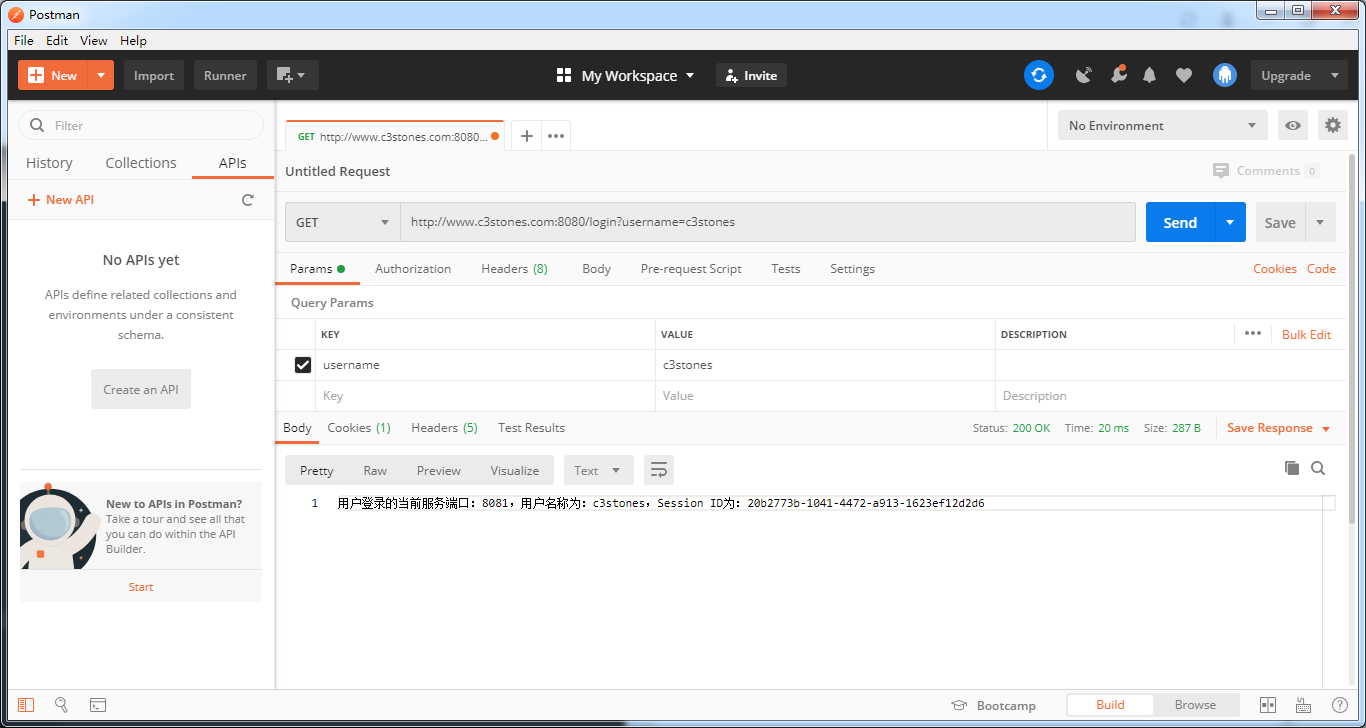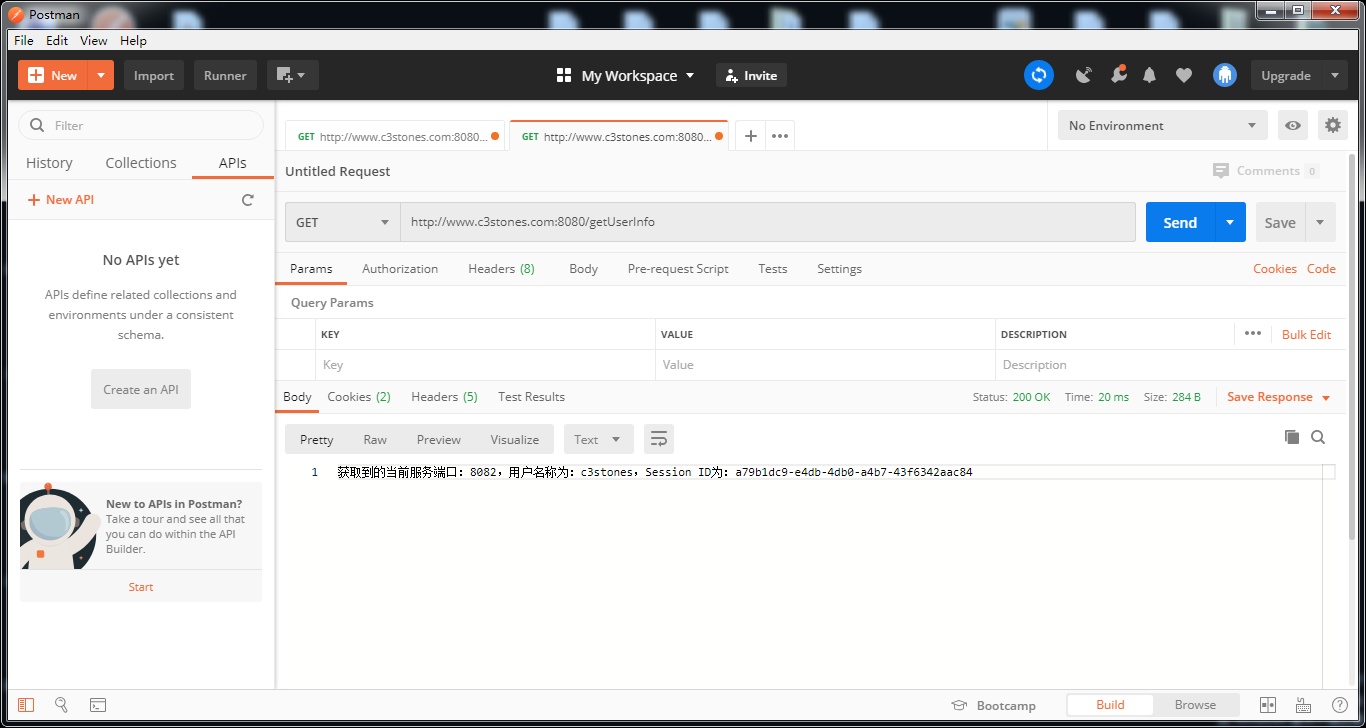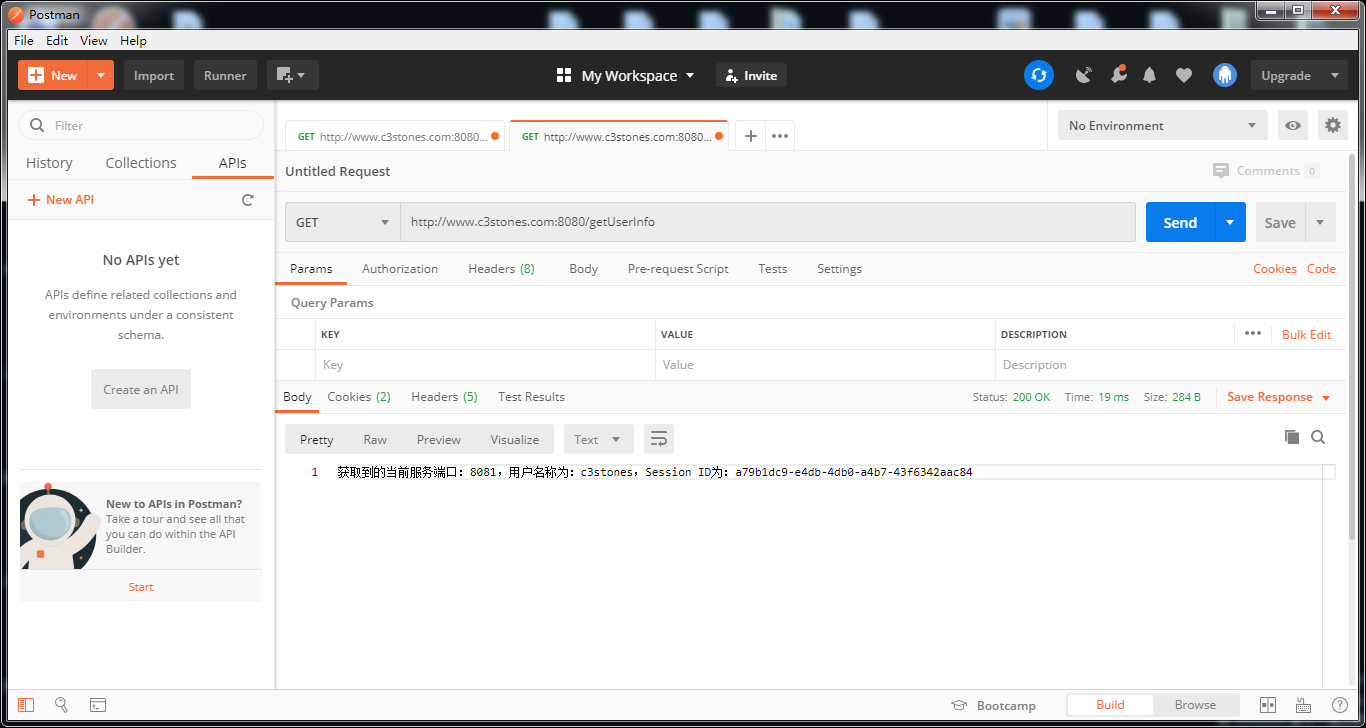1. 分布式Session共享
在分布式集群部署环境下,使用Session存储用户信息,往往出现Session不能共享问题。
例如:服务集群部署后,分为服务A和服务B,当用户登录时负载到服务A登录成功返回用户Session存到本地Cookie中,下一次操作时从Cookie中获取session添加到请求头并负载到服务B,服务B通过Session Id无法获取用户信息,则返回新的Sssion,这样就出现了Session不共享问题。
2. 常见解决方案
- 使用Cookie存储用户信息(不推荐,极其不安全)
- 通过Tomcat内置的Session同步机制(不推荐,可能出现延迟)
- 使用数据库同步Session(不推荐,效率低)
- 使用Nginx的ip_hash策略(可用,同一个ip只能负载到同一个server,消失负载均衡功能)
- 使用token代替Session(推荐,前后端分离/微服务首选)
- 使用Spring Session实现Session共享(推荐,单体应用集群部署可用)
以Spring Session将Session存储在Redis中实现Session共享为例。
3. 演示问题
- 创建Maven工程

- 修改pom.xml
<project xmlns="http://maven.apache.org/POM/4.0.0"
xmlns:xsi="http://www.w3.org/2001/XMLSchema-instance"
xsi:schemaLocation="http://maven.apache.org/POM/4.0.0 http://maven.apache.org/xsd/maven-4.0.0.xsd">
<modelVersion>4.0.0</modelVersion>
<groupId>com.c3stones</groupId>
<artifactId>spring-session-demo</artifactId>
<version>0.0.1-SNAPSHOT</version>
<name>spring-session-demo</name>
<description>Spring Boot Session Demo</description>
<parent>
<groupId>org.springframework.boot</groupId>
<artifactId>spring-boot-starter-parent</artifactId>
<version>2.2.6.RELEASE</version>
<relativePath />
</parent>
<properties>
<java.version>1.8</java.version>
<maven-jar-plugin.version>3.1.1</maven-jar-plugin.version>
</properties>
<dependencies>
<dependency>
<groupId>org.springframework.boot</groupId>
<artifactId>spring-boot-starter-web</artifactId>
</dependency>
<dependency>
<groupId>org.springframework.boot</groupId>
<artifactId>spring-boot-starter-test</artifactId>
<scope>test</scope>
</dependency>
</dependencies>
<build>
<plugins>
<plugin>
<groupId>org.springframework.boot</groupId>
<artifactId>spring-boot-maven-plugin</artifactId>
</plugin>
</plugins>
</build>
</project>
- 创建Controller
import javax.servlet.http.HttpSession;
import org.slf4j.Logger;
import org.slf4j.LoggerFactory;
import org.springframework.beans.factory.annotation.Value;
import org.springframework.web.bind.annotation.RequestMapping;
import org.springframework.web.bind.annotation.RestController;
/**
* 用户Controller
*
* @author CL
*
*/
@RestController
public class UserController {
private static Logger logger = LoggerFactory.getLogger(UserController.class);
@Value("${server.port}")
private Integer port;
/**
* 模拟登录
*
* @param session HttpSession
* @param username 用户名
* @return
*/
@RequestMapping(value = "/login")
public String login(HttpSession session, String username) {
session.setAttribute("username", username);
String msg = String.format("用户登录的当前服务端口:%s,用户名称为:%s,Session ID为:%s", port, username, session.getId());
logger.info(msg);
return msg;
}
/**
* 获取用户信息
*
* @param session HttpSession
* @param username 用户名
* @return
*/
@RequestMapping(value = "/getUserInfo")
public String getUserInfo(HttpSession session) {
String username = (String) session.getAttribute("username");
String msg = String.format("获取到的当前服务端口:%s,用户名称为:%s,Session ID为:%s", port, username, session.getId());
logger.info(msg);
return msg;
}
}
- 创建启动类
import org.springframework.boot.SpringApplication;
import org.springframework.boot.autoconfigure.SpringBootApplication;
/**
* 启动类
*
* @author CL
*
*/
@SpringBootApplication
public class Application {
public static void main(String[] args) {
SpringApplication.run(Application.class, args);
}
}
- 创建配置文件application.yml
server:
port: ${PORT:8080}
- 打jar包
#CMD进入项目根路径执行命令
mvn clean install
- 部署Nginx
Linux(CentOS7)安装Nginx(附简单配置) - Nginx添加配置
upstream backend {
server 192.168.0.100:8081 weight=1;
server 192.168.0.100:8082 weight=1;
}
server {
listen 8080;
server_name 192.168.0.100;
location / {
proxy_pass http://backend;
}
}
- 上传至服务器并启动
#启动Nginx
/usr/local/nginx/sbin/nginx
#启动服务,端口8081
nohup java -jar -DPORT=8081 spring-session-demo-0.0.1-SNAPSHOT &
#启动服务,端口8082
nohup java -jar -DPORT=8082 spring-session-demo-0.0.1-SNAPSHOT &
- 测试
(可选)本地Hosts文件配置域名映射:192.168.0.100 www.c3stones.com
模拟登录,生成Session:

获取用户信息:


从返回可以看出三次调用返回的Session Id均不一致。
使用Nginx默认轮询策略,第一次登录负载到8081端口服务上,生成Session,浏览器缓存Session,第二次获取用户信息,浏览器将8081生成的Session绑定到请求头,Nginx负载到8082服务上,8082服务找不到该Session信息,重新生成Session,浏览器将新生成的Session替换之前保存的Session,重复循环,造成用户登录后,两个服务均无用户信息。
4. Spring Session概述
Spring Session是Spring家族中的一个子项目,Spring Session提供了用于管理用户会话信息的API和实现。它把Servlet容器实现的HttpSession替换为Spring Session,专注于解决Session管理问题,Session信息存储在Redis中,可简单快速的集成到应用中;
Spring Session官网地址:https://spring.io/projects/spring-session
Spring Session的特性:
a. 提供用户Session管理的API和实现;
b. 提供HttpSession,取代web容器的Session;
c. 支持集群的Session处理,解决集群下的Session共享问题;
5. 解决问题,实现Session共享
- 修改pom.xml文件,添加配置
<project xmlns="http://maven.apache.org/POM/4.0.0"
xmlns:xsi="http://www.w3.org/2001/XMLSchema-instance"
xsi:schemaLocation="http://maven.apache.org/POM/4.0.0 http://maven.apache.org/xsd/maven-4.0.0.xsd">
<modelVersion>4.0.0</modelVersion>
<groupId>com.c3stones</groupId>
<artifactId>spring-session-demo</artifactId>
<version>0.0.1-SNAPSHOT</version>
<name>spring-session-demo</name>
<description>Spring Boot Session Demo</description>
<parent>
<groupId>org.springframework.boot</groupId>
<artifactId>spring-boot-starter-parent</artifactId>
<version>2.2.6.RELEASE</version>
<relativePath />
</parent>
<properties>
<java.version>1.8</java.version>
<maven-jar-plugin.version>3.1.1</maven-jar-plugin.version>
</properties>
<dependencies>
<dependency>
<groupId>org.springframework.boot</groupId>
<artifactId>spring-boot-starter-data-redis</artifactId>
</dependency>
<dependency>
<groupId>org.springframework.session</groupId>
<artifactId>spring-session-data-redis</artifactId>
</dependency>
<dependency>
<groupId>org.apache.commons</groupId>
<artifactId>commons-pool2</artifactId>
</dependency>
<dependency>
<groupId>redis.clients</groupId>
<artifactId>jedis</artifactId>
</dependency>
<dependency>
<groupId>org.springframework.boot</groupId>
<artifactId>spring-boot-starter-web</artifactId>
</dependency>
<dependency>
<groupId>org.springframework.boot</groupId>
<artifactId>spring-boot-starter-test</artifactId>
<scope>test</scope>
</dependency>
</dependencies>
<build>
<plugins>
<plugin>
<groupId>org.springframework.boot</groupId>
<artifactId>spring-boot-maven-plugin</artifactId>
</plugin>
</plugins>
</build>
</project>
- 部署Redis
Docker 安装并部署Tomcat、Mysql8、Redis - application.yml添加Redis配置
server:
port: ${PORT:8080}
spring:
redis:
database: 0
host: 192.168.0.100
port: 6379
password: 123456
jedis:
pool:
max-active: 8
max-wait: -1
max-idle: 8
min-idle: 0
timeout: 10000
- 添加Session配置类
import org.springframework.beans.factory.annotation.Value;
import org.springframework.context.annotation.Bean;
import org.springframework.data.redis.connection.RedisStandaloneConfiguration;
import org.springframework.data.redis.connection.jedis.JedisConnectionFactory;
import org.springframework.session.data.redis.config.annotation.web.http.EnableRedisHttpSession;
/**
* Session配置类
*
* @EnableRedisHttpSession:启用支持Redis存储Session</br>
* maxInactiveIntervalInSeconds:Session最大过期时间
*
* @author CL
*
*/
@EnableRedisHttpSession(maxInactiveIntervalInSeconds = 1800)
public class SessionConfig {
@Value("${spring.redis.database}")
private Integer database;
@Value("${spring.redis.host}")
private String host;
@Value("${spring.redis.port}")
private Integer port;
@Value("${spring.redis.password}")
private String password;
/**
* 注入Redis连接工厂
*
* @return
*/
@Bean
public JedisConnectionFactory connectionFactory() {
RedisStandaloneConfiguration configuration = new RedisStandaloneConfiguration();
configuration.setHostName(host);
configuration.setPort(port);
configuration.setPassword(password);
configuration.setDatabase(database);
return new JedisConnectionFactory(configuration);
}
}
- 添加Session初始化类
import org.springframework.session.web.context.AbstractHttpSessionApplicationInitializer;
/**
* Session初始化,向Servlet容器中添加SpringSessionRepositoryFilter
*
* @author CL
*
*/
public class SessionInitializer extends AbstractHttpSessionApplicationInitializer {
public SessionInitializer() {
super(SessionConfig.class);
}
}
- 添加线程池配置类
import org.springframework.context.annotation.Bean;
import org.springframework.context.annotation.Configuration;
import org.springframework.scheduling.concurrent.ThreadPoolTaskExecutor;
/**
* 线程池配置
*
* @author CL
*
*/
@Configuration
public class ThreadPoolConfig {
/**
* Spring Session任务执行器配置
*
* @return
*/
@Bean
public ThreadPoolTaskExecutor springSessionRedisTaskExecutor() {
ThreadPoolTaskExecutor springSessionRedisTaskExecutor = new ThreadPoolTaskExecutor();
springSessionRedisTaskExecutor.setCorePoolSize(8);
springSessionRedisTaskExecutor.setMaxPoolSize(16);
springSessionRedisTaskExecutor.setKeepAliveSeconds(10);
springSessionRedisTaskExecutor.setQueueCapacity(1000);
springSessionRedisTaskExecutor.setThreadNamePrefix("spring-session-thread:");
return springSessionRedisTaskExecutor;
}
}
- 重新打包,部署
- 测试
模拟登录,生成Session:

获取用户信息:


从返回可以看出三次调用返回的Session Id一致,已经实现了Session共享问题。 - 查看Redis

a.Spring Session定时任务触发Session过期,数据类型:Set
Key:spring:session:expirations:XXXXX
b.存储Session,数据类型:Hash
Key:spring:session:sessions:XXXXXXX
c. Redis TTL触发Session过期,数据类型:String
Key:spring:session:sessions:expires:XXXXX
6. 实现原理
当Web服务器接收到http请求后,请求进入SpringSessionRepositoryFilter,将原本需要由Web服务器创建会话的过程转交给Spring Session进行创建,本来创建的会话保存在Web服务器内存中,通过Spring Session创建的会话信息保存第三方的服务中,如:Redis、Mysql等。Web服务器之间通过连接第三方服务来共享数据,实现Session共享!